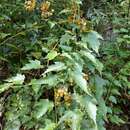Comments
provided by eFloras
Rubus urophyllus Y. C. Liu & F. Y. Lu (Quart. J. Chin. Forest. 9(2): 133. 1976) was treated in Fl. Taiwan is an uncertain species that might be only varietally distinct from R. lambertianus.
- license
- cc-by-nc-sa-3.0
- copyright
- Missouri Botanical Garden, 4344 Shaw Boulevard, St. Louis, MO, 63110 USA
Description
provided by eFloras
Shrubs lianoid, semideciduous, to 3 m tall. Branchlets brown or reddish brown, terete, thinly pubescent or subglabrous, with sparse, curved minute prickles. Leaves simple; petiole 2–4(–5) cm, thinly pubescent or subglabrous, with sparse, minute prickles; stipules caducous, free, to 1 cm, laciniate-parted nearly to base, lobes linear to lanceolate, thinly pubescent or subglabrous; blade broadly ovate, rarely oblong-ovate, 5–10(–12) × 4–8 cm, 5-veined, abaxially pilose, more densely so along veins, rarely glabrous, with sparse, minute prickles along midvein, adaxially pilose or hairy only along veins, base cordate, margin distinctly 3–5-lobed or undulate, serrulate, apex acuminate. Inflorescences terminal or axillary, terminal ones usually cymose panicles, 10–15 cm, axillary ones often subracemes, shorter, sometimes flowers few in clusters in leaf axils; rachis and pedicels thinly pubescent, subglabrous, or glabrous; bracts 6–9 mm, margin laciniate lobed; lobes linear, puberulous. Pedicel 5–10 mm. Flowers 7–9 mm in diam. Calyx abaxially thinly pubescent; sepals ovate-lanceolate or triangular-lanceolate, 5–8 × 2.5–4 mm, margin entire, apex acuminate, margin of inner sepals gray tomentose. Petals white, obovate, glabrous, slightly shorter than or nearly as long as sepals, base clawed. Stamens many, somewhat shorter than petals; filaments broad, complanate. Pistils ca. 15–20, slightly shorter than or ca. as long as stamens, glabrous. Aggregate fruit red at maturity, subglobose, 6–8 mm in diam., glabrous, with many drupelets; pyrenes small, ca. 2 mm, prominently rugose. Fl. Jul–Aug, fr. Sep–Nov. 2n = 28.
- license
- cc-by-nc-sa-3.0
- copyright
- Missouri Botanical Garden, 4344 Shaw Boulevard, St. Louis, MO, 63110 USA
Distribution
provided by eFloras
Anhui, Fujian, Gansu, Guangdong, Guangxi, Guizhou, Hainan, Henan, Hubei, Hunan, Jiangsu, Jiangxi, Shaanxi, Sichuan, Taiwan, Yunnan, Zhejiang [Japan, Thailand].
- license
- cc-by-nc-sa-3.0
- copyright
- Missouri Botanical Garden, 4344 Shaw Boulevard, St. Louis, MO, 63110 USA
Habitat
provided by eFloras
Slopes, roadsides, montane valleys, stony ravines, grasslands, thickets, sparse forests, forest margins, moist places; 200--2500 m.
- license
- cc-by-nc-sa-3.0
- copyright
- Missouri Botanical Garden, 4344 Shaw Boulevard, St. Louis, MO, 63110 USA
Rubus lambertianus: Brief Summary
provided by wikipedia EN
Rubus lambertianus is a flowering plant species in the genus Rubus found in Southern China (including Hainan), Taiwan, Japan, and Thailand. Its ploidy is 2n = 4X (tetraploid). The ellagitannins lambertianin A, B, C and D can be found in R. lambertianus.
- license
- cc-by-sa-3.0
- copyright
- Wikipedia authors and editors

